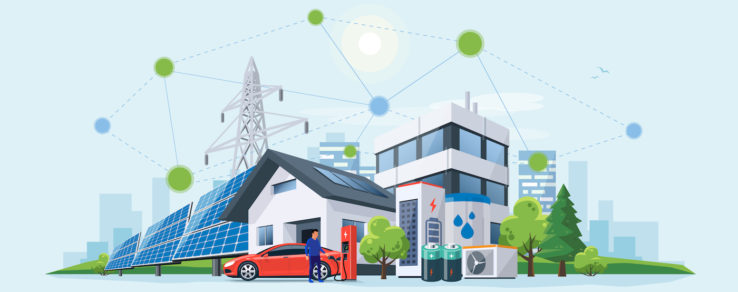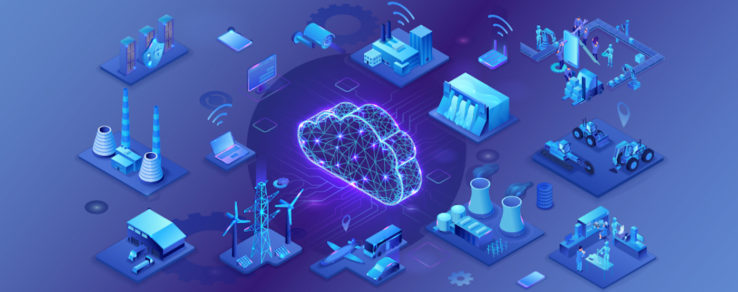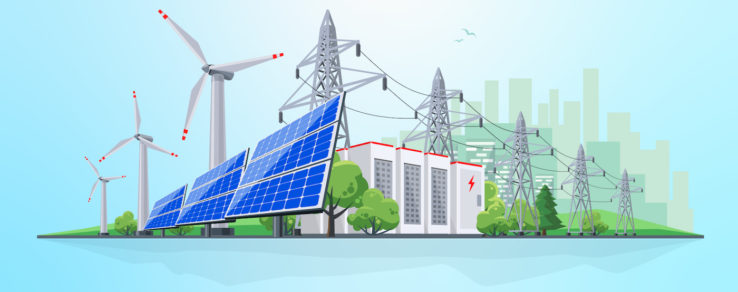Microgrids are a much smaller version of an energy utility’s megagrid: a network that connects a few buildings, a campus or a neighborhood. They comprise distributed energy resources, energy storage systems and loads under one control system.
Microgrids connect to the main grid at a point of “common coupling,” which maintains voltage at the same level. A switch can automatically or manually separate the microgrid from the main grid, and it then functions as an island. By controlling distributed energy resources as a single entity, they can also act as a bidirectional energy network supplying power to the megagrid if necessary.
With the power of microgrids, it’s no wonder they’ve become a growing trend in the industry. This what energy utilities need to know as they advise customers about the pros and cons of microgrid technology.
Distributed energy resources spur microgrid growth
A record number of microgrids (546) were installed in the United States in 2019, although annual capacity was down 7% from 2018, according to Wood McKenzie. This is in line with a trend toward smaller (below 5 MW) replicable modular systems that started in 2017.
The pandemic has slowed growth so far in 2020. However, FERC Order 2222 will be a major post-pandemic accelerant for microgrids, paving the way for aggregated distributed energy resources (DER) to compete with traditional power plants in wholesale markets. Also, a trend toward third-party ownership of microgrids is driving the development of microgrids. The federal government has also shifted its focus from energy efficiency to resiliency through microgrids over the last few years.
Powering microgrids with renewable energy sources
Microgrids can be powered by distributed generators, batteries or renewable sources, such as solar energy. It’s not uncommon to have a mix of different power sources. Renewable energy sources in microgrids are also enabling beneficial electrification and decarbonization.
Microgrids are still primarily fossil fuel-driven, though, with 86% of new microgrid new capacity in 2019 powered by diesel fuel and natural gas. However, forecasters expect renewable power sources (solar, wind and hydropower) to drive 35% of new microgrid capacity by 2025.
Cutting costs and reducing emissions
Microgrids offer many benefits, including providing resilience in extreme weather conditions. Wildfires, hurricanes and floods often threaten the grid. Apart from emergencies, microgrids can be used for energy independence or sustainability, such as distributing solar power within a neighborhood. They can relieve pressure on the main grid during peak demand.
Microgrids benefit utility customers by providing a more reliable power supply, reducing emissions, cutting costs and connecting to local resources too small for the traditional grid.
Microgrid case studies: Resiliency at work
Microgrids are everywhere and there are a variety of sizes for any number of situations. Take, for instance, New York University’s island microgrid, which was put to the test during Hurricane Sandy in 2012. This microgrid continued to provide power to much of the NYU campus, supplying electricity to 22 buildings and heat to 37 others.
The Fort Collins, Colorado, microgrid is part of a larger project known as the Fort Collins Zero Energy District. The district includes New Belgium Brewery, Colorado State University’s main campus, and other facilities. The goal of the microgrid is to produce as much energy as it consumes. The district’s distributed generation and load-shedding capabilities total 5 megawatts, or enough electricity to power about 3,750 homes.
Arizona Public Service (APS) built, owns, operates and maintains a 25 MW microgrid at the Marine Corps Air Station (MCAS) Yuma. This installation makes MCAS Yuma 100% resilient to external grid failures and offers APS civilian customers peaking capacity and frequency response reserves.
Several manufacturers of gas-fueled engines, including Siemens, are launching microgrid systems. Using Siemens microgrid management software, one project is testing the concept of microgrid clusters. The Bronzeville Community Microgrid in Illinois is designed to serve 10 critical facilities and over 1,000 customers, including the Chicago Police Department. It will also connect to a nearby microgrid at the Illinois Institute of Technology.
Microgrids offer major benefits to utilities
As these examples demonstrate, there are a variety of ways that microgrids can help communities by distributing renewable energy and backing up the main power grid during natural disasters or outages.
The benefits to utilities are anything but micro. Microgrids can improve the operation and stability of the regional electric grid and provide increased resiliency to critical operations customers like hospitals. Plus, they can shore up aging utility infrastructure and decrease peak demand. For energy utilities, thinking small has its advantages.
Make sure your business customers are up to speed on new energy technologies with an eNewsletter solution from Questline Digital.




